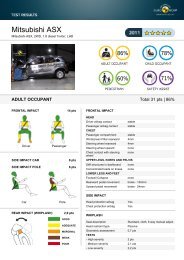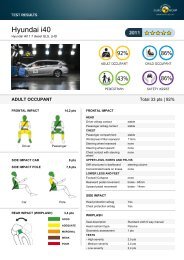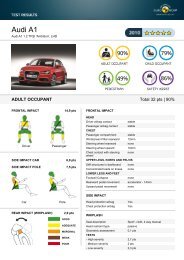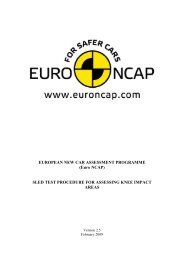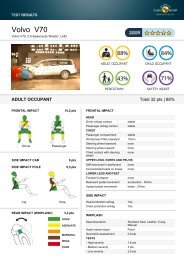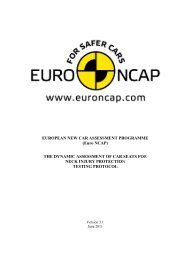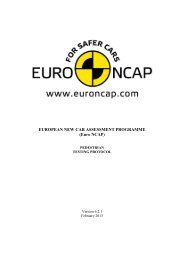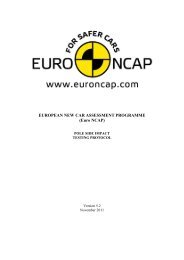Pedestrian Test Protocol - Euro NCAP
Pedestrian Test Protocol - Euro NCAP
Pedestrian Test Protocol - Euro NCAP
You also want an ePaper? Increase the reach of your titles
YUMPU automatically turns print PDFs into web optimized ePapers that Google loves.
1 VEHICLE PREPARATION<br />
1.1 Unladen Kerb Weight<br />
1.1.1 The capacity of the fuel tank will be specified in the manufacturer’s booklet. This<br />
volume will be referred to throughout as the ‘fuel tank capacity’.<br />
1.1.2 Syphon most of the fuel from the tank and then run the car until it has run out of fuel.<br />
1.1.3 Refill the fuel tank with fuel (or an equivalent mass of water or other ballast) to its fuel<br />
tank capacity.<br />
1.1.4 Check the oil level and top up to its maximum level if necessary. Similarly, top up the<br />
levels of all other fluids to their maximum levels if necessary.<br />
1.1.5 Ensure that the vehicle has its spare wheel on board along with any tools supplied with<br />
the vehicle. Nothing else should be in the vehicle.<br />
1.1.6 Ensure that all tyres are inflated according to the manufacturer’s instructions for half<br />
load.<br />
1.1.7 Remove the front vehicle license plate and its holder/brackets if these are removable<br />
from the bumper.<br />
1.1.8 Measure the front and rear axle weights and determine the total weight of the vehicle.<br />
The total weight is the ‘unladen kerb weight’ of the vehicle. Record this weight in the<br />
test details.<br />
1.2 Additional Weights<br />
1.2.1 Put the fore-aft adjustment of both front seats in their mid-positions. If there is no notch<br />
at the mid-position, use the first notch immediately rearward.<br />
1.2.2 Place a 75kg mass on the driver’s seat and a 75kg mass on the front passenger’s seat.<br />
1.2.3 Ensure that the front wheels are in the straight ahead position.<br />
1.2.4 If the suspension is adjustable in any way, ensure that the vehicle is at the correct<br />
attitude for travelling at 40km/h. See Section 1.4.<br />
1.3 Suspension Settling<br />
1.3.1 Roll the vehicle forwards by a distance of at least 1 metre<br />
1.3.2 Roll the vehicle backwards by a distance of at least 1 metre<br />
1.3.3 Repeat steps 1.3.1 and 1.3.2 for three complete cycles. Note: This procedure may be<br />
inappropriate for cars which have to be set up as described in Section 1.2.4.<br />
1.3.4 Measure and record the ride heights of the vehicle at the point on the wheel arch in the<br />
same transverse plane as the wheel centres. Do this for all four wheels.<br />
1.4 Normal Ride Attitude<br />
1.4.1 After following the above procedures the vehicle is in its Normal Ride Attitude when<br />
the vehicle attitude is in running order positioned on the ground, with the tyres inflated<br />
to the recommended pressures, the front wheels in the straight-ahead position, with<br />
maximum capacity of all fluids necessary for operation of the vehicle, with all standard<br />
equipment as provided by the vehicle manufacturer, with a 75kg mass placed on the<br />
driver's seat and with a 75kg mass placed on the front passenger's seat, and with the<br />
suspension set for a driving speed of 40km/h in normal running conditions specified by<br />
the manufacturer (especially for vehicles with an active suspension or a device for<br />
automatic levelling).<br />
1.4.2 The manufacturer shall specify the Normal Ride Attitude with reference to the vertical<br />
(Z) position of any marks, holes, surfaces and identification signs on the vehicle body,<br />
above the ground. These marks shall be selected such as to be able to easily check the<br />
vehicle front and rear ride heights and vehicle attitude. If the reference marks are found<br />
Version 7.0<br />
March 2013<br />
1



